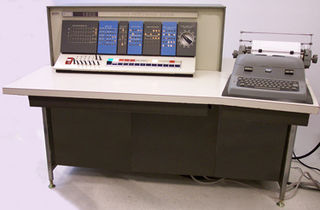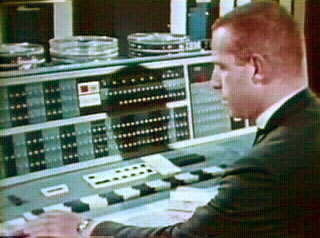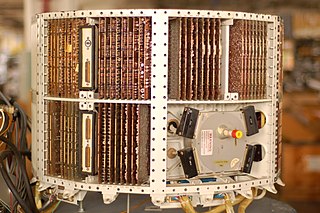Related Research Articles

The IBM System/360 (S/360) is a family of mainframe computer systems that was announced by IBM on April 7, 1964, and delivered between 1965 and 1978. It was the first family of computers designed to cover both commercial and scientific applications and a complete range of applications from small to large. The design distinguished between architecture and implementation, allowing IBM to release a suite of compatible designs at different prices. All but the only partially compatible Model 44 and the most expensive systems use microcode to implement the instruction set, featuring 8-bit byte addressing and fixed point binary, fixed point decimal and hexadecimal floating-point calculations.
The GE-600 series is a family of 36-bit mainframe computers originating in the 1960s, built by General Electric (GE). When GE left the mainframe business the line was sold to Honeywell, which built similar systems into the 1990s as the division moved to Groupe Bull and then NEC.

The IBM 704 is the model name of a large digital mainframe computer introduced by IBM in 1954. It was the first mass-produced computer with hardware for floating-point arithmetic. The IBM 704 Manual of operation states:
The type 704 Electronic Data-Processing Machine is a large-scale, high-speed electronic calculator controlled by an internally stored program of the single address type.

The IBM 1620 was announced by IBM on October 21, 1959, and marketed as an inexpensive scientific computer. After a total production of about two thousand machines, it was withdrawn on November 19, 1970. Modified versions of the 1620 were used as the CPU of the IBM 1710 and IBM 1720 Industrial Process Control Systems.

The IBM 7090 is a second-generation transistorized version of the earlier IBM 709 vacuum tube mainframe computer that was designed for "large-scale scientific and technological applications". The 7090 is the fourth member of the IBM 700/7000 series scientific computers. The first 7090 installation was in December 1959. In 1960, a typical system sold for $2.9 million or could be rented for $63,500 a month.

The IBM 709 is a computer system that was initially announced by IBM in January 1957 and first installed during August 1958. The 709 was an improved version of its predecessor, the IBM 704, and was the third of the IBM 700/7000 series of scientific computers. The improvements included overlapped input/output, indirect addressing, and three "convert" instructions which provided support for decimal arithmetic, leading zero suppression, and several other operations. The 709 had 32,768 words of 36-bit magnetic core memory and could execute 42,000 add or subtract instructions per second. It could multiply two 36-bit integers at a rate of 5000 per second.

The IBM 700/7000 series is a series of large-scale (mainframe) computer systems that were made by IBM through the 1950s and early 1960s. The series includes several different, incompatible processor architectures. The 700s use vacuum-tube logic and were made obsolete by the introduction of the transistorized 7000s. The 7000s, in turn, were eventually replaced with System/360, which was announced in 1964. However the 360/65, the first 360 powerful enough to replace 7000s, did not become available until November 1965. Early problems with OS/360 and the high cost of converting software kept many 7000s in service for years afterward.
x86 assembly language is the name for the family of assembly languages which provide some level of backward compatibility with CPUs back to the Intel 8008 microprocessor, which was launched in April 1972. It is used to produce object code for the x86 class of processors.
The TMS9900 was one of the first commercially available, single-chip 16-bit microprocessors. Introduced in June 1976, it implemented Texas Instruments' TI-990 minicomputer architecture in a single-chip format, and was initially used for low-end models of that lineup.
In computing, a word is the natural unit of data used by a particular processor design. A word is a fixed-sized datum handled as a unit by the instruction set or the hardware of the processor. The number of bits or digits in a word is an important characteristic of any specific processor design or computer architecture.
NAR 2 is a theoretical model of a 32-bit word computer created by Faculty of Mathematics of University of Belgrade professor Nedeljko Parezanović as an enhancement to its predecessor, NAR 1. It was used for Assembly language and Computer architecture courses. The word "nar" means Pomegranate in Serbian. Many NAR 2 simulators have been created — for instance, one was named "Šljiva" as that fruit grows in Serbia, while "nar" does not.

The IBM 8000 series was a proposed transistor-based successor to the IBM 7000 series. Important engineers on the project included Fred Brooks and Gerry Blaauw. The project plan for the 8000 series was presented by Fred Brooks in January 1961. Despite some technical successes, the project became a political football, amid IBM's search for a unified product line. The project was canceled in 1961 by Bob Evans, supplanted by the successful System/360 series.

The D-17B (D17B) computer was used in the Minuteman I NS-1OQ missile guidance system. The complete guidance system contained a D-17B computer, the associated stable platform, and power supplies.

The RCA Spectra 70 is a line of electronic data processing (EDP) equipment that was manufactured by the Radio Corporation of America’s computer division beginning in April 1965. The Spectra 70 line included several CPU models, various configurations of core memory, mass-storage devices, terminal equipment, and a variety of specialized interface equipment.
The PDP-11 architecture is a 16-bit CISC instruction set architecture (ISA) developed by Digital Equipment Corporation (DEC). It is implemented by central processing units (CPUs) and microprocessors used in PDP-11 minicomputers. It was in wide use during the 1970s, but was eventually overshadowed by the more powerful VAX architecture in the 1980s.
The IBM System/360 architecture is the model independent architecture for the entire S/360 line of mainframe computers, including but not limited to the instruction set architecture. The elements of the architecture are documented in the IBM System/360 Principles of Operation and the IBM System/360 I/O Interface Channel to Control Unit Original Equipment Manufacturers' Information manuals.
ICT 1900 was a family of mainframe computers released by International Computers and Tabulators (ICT) and later International Computers Limited (ICL) during the 1960s and 1970s. The 1900 series was notable for being one of the few non-American competitors to the IBM System/360, enjoying significant success in the European and British Commonwealth markets.

The SDS 9 Series computers are a backward compatible line of transistorized computers produced by Scientific Data Systems in the 1960s and 1970s. This line includes the SDS 910, SDS 920, SDS 925, SDS 930, SDS 940, and the SDS 945. The SDS 9300 is an extension of the 9xx architecture. The 1965 SDS 92 is an incompatible 12-bit system built using monolithic integrated circuits.
К1839 is a microprocessor chipset developed between 1984 and 1989 at the Angstrem Research Institute by the same team that developed the 1801BMx series of CPUs. It was the first Soviet, and later the first Russian 32-bit microprocessor system. From a programmer's point of view, it was a complete replica of the VAX 11/750 Comet and included floating-point arithmetic, unlike the MicroVAX microprocessors produced by DEC. The chipset included a processor, a coprocessor for integer and floating-point arithmetic, a memory controller and a bus adapter. It was fabricated in a 3 µm process. The Electronika-32 computer and a VAX-PC board were built based on this chipset, as well as the aerospace on-board digital computer SB3541. The 1839 chipset is still in production, and is used in the control systems of the GLONASS-M satellites.

The WD16 is a 16-bit microprocessor introduced by Western Digital in October 1976. It is based on the MCP-1600 chipset, a general-purpose design that was also used to implement the DEC LSI-11 low-end minicomputer and the Pascal MicroEngine processor. The three systems differed primarily in their microcode, giving each system a unique instruction set architecture (ISA).
References
- 1 2 3 4 5 The IBM 4020 Military Computer - General Information (PDF). IBM Federal Systems Division. October 31, 1959.